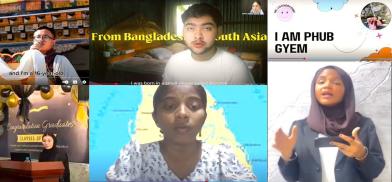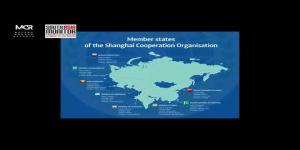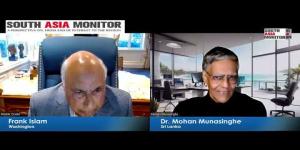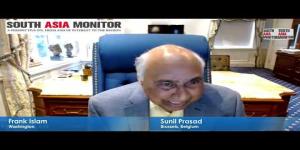From Herat to Hyderabad, Jaffna to Jhapa, Young Voices Reimagine South Asia
Together, these voices converged on common ground: universal education, ecological cooperation, equitable trade, soft borders, and a revitalised SAARC that works for people rather than politics. Or, as one participant Ayesha Ahmed Quadri from India put it: “In the hands of South Asia lie the seeds of unity, compassion, peace, humility, and growth, ready to blossom beyond borders and history.”

When Lojana Venthan, from Sri Lanka’s war-affected northern province, began her video message, her voice carried the weight of generations scarred by conflict.
“True peace means everyone can live with freedom and dignity without fear,” she said.
Lojana Venthan was one of nearly 200 young Southasians who responded to a unique challenge: “If I were the President or Prime Minister of my country, what would my vision for Southasia be?”
The call went out on International Youth Day, 12 August 2025, as part of the First Southasia Commemoration of the Doyens of Peace, co-organised by the Southasia Peace Action Network (Sapan).
From Afghanistan to Sri Lanka, Bangladesh to Bhutan, the voices converged into a striking mosaic of hope. A jury shortlisted two videos from each of the eight countries. These 16 finalists became the centerpiece of an online gathering, offering a rare collective vision for a cooperative, connected region.
One of the most moving appeals came from Samana Faizi, 23, of Afghanistan, who introduced herself as “a daughter of Southasia, a region of beauty, history, and untapped potential.”
Speaking against the backdrop of her country’s turmoil, she painted a picture of shared struggles across borders — from girls walking miles to unsafe schools in Pakistan to climate-displaced families in Bangladesh.
“These challenges do not define us,” she insisted. “What defines us is how we respond, and what future we choose to build.”
Samana Faizi outlined a five-pillar regional vision: universal education with cross-border exchange programs, inclusive economic growth through a South Asian free trade zone, healthcare accessible across borders, security through cooperation and peace education, and environmental justice via joint reforestation and renewable energy projects.
Her rallying cry was clear: “We do not need more weapons. We need more schools. We do not need more division. We need more unity.”
From Bagmati in Nepal, 17-year-old Arya Gautam reminded listeners that “peace in South Asia must not remain a privilege. It must become a birthright.”
She pictured education exchanges across frontiers: “A girl from Herat can study in Hyderabad, a boy from Jaffna can teach in Jhapa.”
Bhutan’s voices brought education into sharp focus. Phub Gyem, 19, a geology undergraduate from Thimphu, shared her personal experience in a rural school: “We get really less opportunity than the urban schools. Development is much higher in towns than in villages.”
Her bold proposal was to separate education from government control, arguing that “education should be a national priority, not a political instrument. Separating it from direct government control allows it to grow, adapt, and serve society more effectively.”
From Bangladesh, Sudipta Sarker, 21, drew on his childhood in the remote village of Bortoli. “In class 3, when I wrote that one day I would be prime minister, the whole class laughed. Even the teacher smiled politely,” he recalled.
For him, the laughter became fuel. He outlined plans for solar-powered digital classrooms in every village, better pay and dignity for teachers, national health coverage for all, and skill labs in high schools to prepare students “not just to be job-ready, but change-ready.” His vision was rooted in justice: “Your health should never depend on your wallet. It should depend on your right to live.”
Climate justice unites
In Pakistan, Nisbat Shah from Sindh province warned starkly: “Without climate action, there is no future , not for Pakistan, not for India, not for Sri Lanka, not for any of us.”
She called for a Southasia-wide climate corps and renewable energy projects.
Elaf Abdul Latheef, from the Maldives, invoked the rising seas threatening her homeland: “Even the smallest boat can sail through the strongest of waves. With courage, with vision, with unity, Southasia can sail through these waves and thrive.”
And in India, Zara Ahmed, offered a simple but powerful truth: “True peace doesn’t come from treaties. It comes from trust.”
Together, these voices converged on common ground: universal education, ecological cooperation, equitable trade, soft borders, and a revitalised SAARC that works for people rather than politics. Or, as one participant Ayesha Ahmed Quadri from India put it: “In the hands of South Asia lie the seeds of unity, compassion, peace, humility, and growth, ready to blossom beyond borders and history.”
After the video showcase, youth panellists debated how to move from aspiration to policy.
Darshika Sivapragasam from Sri Lanka pressed for youth political representation and bridging the rural–urban digital divide.
“We must turn dialogues into joint projects so cooperation becomes a habit, not an expectation,” urged Silab Naseri from Afghanistan.
Prasansa Thapa of Nepal proposed a permanent South Asia Youth Forum, while Bipasha Saed from Bangladesh called for dismantling militarised borders and investing in human rights and education. Kabir Rao from India linked today’s aspirations to the spirit of the Bandung Conference, urging deliberate cultural exchange and ecological cooperation.
The commemoration honoured Admiral L. Ramdas, Karamat Ali, and Tapan Bose, doyens of peace whose lifework inspired the event. Closing the programme, peace activist and Sapan founding member, Lalita Ramdas, delivered a message as both witness and elder, “We want a pledge from decision-makers for active youth participation in shaping policies from local to global. The baton must be passed now, not 20 years later.”
South Asia See Itself Anew
Her words turned youthful dreams into a challenge for today’s leaders: to channel these aspirations into action rather than let them fade as sentiment.
Listening to these young voices, some hopeful, some urgent, all deeply sincere, it was clear that they weren’t just imagining themselves as presidents or prime ministers. They were demanding that South Asia see itself anew, through their eyes, and act with the courage they are ready to bring.
At a time of hardening borders and divisive politics, these young people remind us that the real future of the region lies not in walls or weapons but in classrooms, rivers, and the simple trust that neighbours can be family. On International Youth Day 2025, those seeds crossed borders without visas or security checks, carried in five-minute videos full of courage and conviction. The challenge now is to ensure they are nurtured.
(The writer is an Indian journalist and former Fulbright-Nehru Master’s scholar at Rutgers University, US. She is passionate about creating authentic and powerful stories about South Asia, aiming to foster understanding and connection through compelling narratives. By special arrangement with Sapan)








Post a Comment